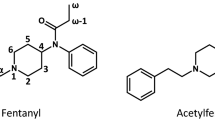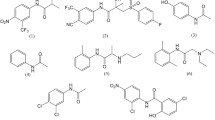Abstract
The metabolism of the novel designer drug 3-fluoromethcathinone (3-FMC), sold as “legal highs”, was investigated in vitro via cryopreserved rabbit liver slices. The pharmacological properties and toxicological effects of 3-FMC and its metabolites are not known yet. It can be assumed that 3-FMC will cause effects similar to 4-methylmethcathinone (mephedrone) and methcathinone. For the metabolism studies, pretests were performed with rabbit liver slices incubated with kavain to evaluate optimal conditions. Finally, six known metabolites of kavain were revealed and therefore sufficient information about the suitability of the enzyme system of the rabbit liver slices was obtained. Under optimized conditions, 3-FMC was added to Krebs–Henseleit buffer, pH 7.4 containing NADPH and bicarbonate and incubated with a single rabbit liver slice at 37°C. The metabolism was monitored at 5, 30 and 180 min, respectively. The metabolites formed via the former cryopreserved rabbit liver slices were examined by LC/MS-TOF. Metabolites were identified by their exact masses and isotopic patterns. 3-Fluorocathinone, 3-fluorocathinone-imine, hydroxy-3-fluoromethcathinone and 3-fluoromethcathinone-diol were formed as the main metabolites.







Similar content being viewed by others
References
Belhadj-Tahar H, Sadeg N (2005) Methcathinone: a new postindustrial drug. Forensic Sci Int 153:99–101
EMCDDA, Robertson K (2010) Drugnet Europe—newsletter of the European Monitoring Centre for Drugs and Drug Addiction. ISSN: 0873–5379 69:1–8 http://www.emcdda.europa.eu/online/annual-report/2010/new-drugs-and-trends/2
Archer PR (2009) Fluoromethcathinone, a new substance of abuse. Forensic Sci Int 185(1–3):10–20
Brandt SD, Sumnall HR, Measham F, Cole J (2010) Analyses of second-generation ‘legal highs’in the UK: initial findings. Drug Test Anal 2(8):377–382
Tarbah AF (2003) Analytical studies on the kavain metabolism in human specimen and liver cell lines. Dissertation, Heinrich-Heine University
Krebs AH, Henseleit K (1932) Untersuchungen über die Harnstoffbildung im Tierkörper. Hoppe-Seyler‘s Zeitschrift f. physiol. Chemie 33–66
Deutsch W (1936) An improvement of Warburg’s method for cutting tissue slices for respiratory experiments. Proc Physiol Soc J Physiol 87:56–57
Härtter S (2000) In vitro Methoden zur Untersuchung des Phase-I Metabolismus. Pharmazie in unserer Zeit 29(6):365–371
Panoutsopoulos IG (2005) Phenylacetaldehyde oxidation by freshly prepared and cryopreserved guinea pig liver slices: the role of aldehyde oxidase. Int J Toxicol 24(2):103–109
Lisboa PB, Knuppen R, Breuer H (1965) Stoffwechsel von 7-substituierten phenolischen Steroiden in der Rattenleber. Biochim Biophys Acta 97(3):557–563
Markantonis LS, Kyroudis A, Beckett HA (1986) The stereoselective metabolism of dimethylpropion and monomethylpropion. Biochem Pharmacol 35(3):529–532
Brenneisen R, Geisshüsler S, Schorno X (1986) Metabolism of cathinone to (-)-norephedrine and (-)-norpseudoephedrine. J Pharm Pharmacol 38(4):298–300
Kraemer T, Maurer HH (2002) Toxicokinetics of amphetamines: metabolism and toxicokinetic data of designer drugs, amphetamine, methamphetamine, and their N-alkyl derivates. Therapeutic Drug Monitoring 24:277–289
Wright J, Cho AK, Gal J (1977) The metabolism of amphetamine in vitro by rabbit liver preparations: a comparison of R(-) and S (+) enantiomers. Xenobiotica 7(5):257–266
Meyer RM, Maurer HH (2010) Metabolism and toxicological detection of emerging drugs of abuse in Germany and Israel (2010) at annual meeting abstract: abstracts from the join American-Israeli Medical Toxicology and the Israel Society of Toxicology November 16–17, Rambam, Medical Center, Haifa, Israel. J Med Toxicol
Meyer RM, Wilhelm J, Peters TF, Maurer HH (2010) Beta-keto amphetamines: studies on the metabolism of the designer drugs mephedrone and toxicological detection of mephedrone, butylone, and methylone in urine using gas chromatography-mass spectrometry. Anal Bioanal Chem 397(3):1225–1233
Ethical standards
We declare that the present study complies with the current German law. The rabbit was slaughtered by the butcher and sold for food consumption. Usually, the liver would have been sold together with the slaughtered rabbit, the study is therefore not declared as an animal test.
Acknowledgements
We would like to thank the non profit association VEGaS (Verein zur Erforschung der Gefahren durch Drogen und andere Rauschmittel im Straßenverkehr e.V. ) in Duesseldorf, Germany for the appropriation of financial aids.
Conflict of interest
The authors declare that they have no conflict of interest.
Animal welfare
No animal experiment was carried out.
Author information
Authors and Affiliations
Corresponding author
Rights and permissions
About this article
Cite this article
Pawlik, E., Plässer, G., Mahler, H. et al. Studies on the phase I metabolism of the new designer drug 3-fluoromethcathinone using rabbit liver slices. Int J Legal Med 126, 231–240 (2012). https://doi.org/10.1007/s00414-011-0601-6
Received:
Accepted:
Published:
Issue Date:
DOI: https://doi.org/10.1007/s00414-011-0601-6




